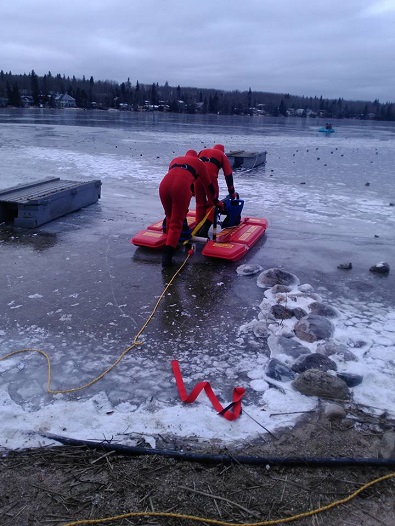One photo of the rescue on Emma Lake from Nov. 19. Photo courtesy Facebook, Lakeland & District Fire Department
Ice started to form on many of Saskatchewan’s lakes this weekend, and that led to a close call for two people who fell through thin ice on Emma Lake.
It was one of the first ice rescues of the season, and the two people were safely brought to shore by Lakeland Fire Department. One person had been walking on ice and another had been nearby in a paddle boat, according to the department.
The local department says there was open water only days before this incident, and is urging people to wait until bodies of water properly freeze up before walking on ice. They usually get ice thickness details from conservation officers to post on Facebook, but hadn’t started that process yet this year due to the high temperatures heading into winter.
Lyle Karasiuk with Parkland Ambulance wasn’t involved in this rescue, but says when paramedics encounter ice rescues it’s usually in circumstances like this.
“The ice is just starting to form and people may think that it’s solid close to the shore when it really isn’t. You need to think about, even when you get onto the ice just to walk it usually needs four inches worth of ice to get under there. There’s nowhere in Saskatchewan that you’re going to find a river, a lake, with four inches of ice on it yet,” he said.
According to the Red Cross, you can tell strong ice by its colour: the thickest ice is clear blue, white or snowy ice is half as thick, and grey ice is unsafe.
Karasiuk said there are some important tips for people to keep in mind.
“If you’re going out somewhere and you hear ice cracking, you need to go back where you came from, not continue to go forward faster. If you do go through the ice you need to get yourself out as quickly as you can,” he said.
For those who witness someone go through ice, Karasiuk said it’s best to get anything – a stick, rope, paddle, or other item – to reach out to that person and not put yourself in danger.
After someone is out of the water, the next most urgent thing to do is to get them warm and dry.
As an example, if someone falls through an unexpected patch of thin ice while hunting, Karasiuk advises building a fire as soon as possible as well as getting out of wet clothes and wrapped in something to maintain body heat.
He has seen patients in different states after an ice rescue: mild cases where people are awake and can still talk; more severe hypothermic cases where people are “not making much sense or not responding properly;” and in extreme cases someone’s body temperature is so low that they’re completely unconscious.
Karasiuk said it’s valuable to have a simple space saver foil blanket as well as a more substantive blanket in their vehicle or nearby when they’re participating in outdoor activities.

